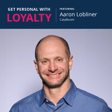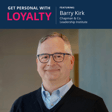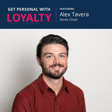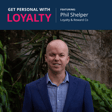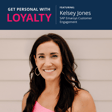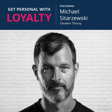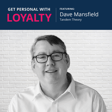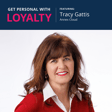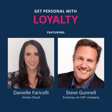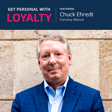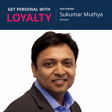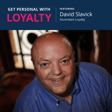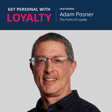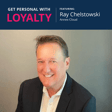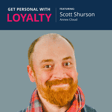Become a Creator today!Start creating today - Share your story with the world!
Start for free
00:00:00
00:00:01

Taking Loyalty Global while Remaining Local
In this podcast episode, Steve Sickel, Managing Partner at The Mallett Group, shares insights on how to manage loyalty programs for multinational companies with both local and international customer bases, and how to balance global benefits with localized extras to meet and exceed your customers’ expectations. We’ll also cover the cost considerations that go into designing a successful program. Get ready to get personal!
Transcript
Steve Sickle's Entry into Loyalty Field
00:00:10
Speaker
Get personal with loyalty, where we're discussing using loyalty to deliver personalized, relevant customer experiences. Hello, everybody. I'm your host, Aaron Rees, and today I'm here with Steve Sickle, the managing partner of the Mallet Group. Welcome, Steve. Thank you. Hi, Aaron. Good morning. Great to be here. I'm really excited for this conversation. Let's start, though, with letting people know a little bit about you. How did you get started in loyalty?
00:00:37
Speaker
Oh boy, yeah, I kind of slipped into loyalty actually when I was in graduate school and with an intention to go into be a product manager with a CPG company with Proctor, one of those. And I got intrigued by, you know, on one of the boards there in graduate school, they had this these promotions through Continental Airlines and American Express that was targeting the student market, getting students to sign up for a credit card.
00:01:05
Speaker
with the incentive of these really heavily discounted discount vouchers.
Career Journey in Loyalty Sector
00:01:09
Speaker
And I was really intrigued by that. And so I tracked down who was leading that campaign at Continental, and it came out of a group called Marketing Programs Group, which also did the loyalty program, the One Pass program. So I got in there and finable my way into an internship over the summer while I was in graduate school and became infatuated and just fell in love with loyalty.
00:01:33
Speaker
And so from there I did a hard right away from CPG and I wanted to get into travel and loyalty. So my second year was all focused on that. And when I got out Continental Airlines offered me a position and I went into the loyalty program there and I never looked back. So started there as a manager and then worked my way up to ran the ran the loyalty practice globally at Continental before to merger with United.
00:01:59
Speaker
Then I went over to and tried my fields over on the hotel side and I ran the loyalty practice at a company called IHG, Intercontinental Hotels Group, which no one knows that name, but that's one of the largest hotel companies in the world. They have Holiday Inn, Holiday Inn Express, Crown Plaza, the Intercontinental brand, of course. So, like, you know, 5,000 hotels in 50 or 60 countries around the loyalty practice there. I did that for a long time and then grew up in that company and left there as
00:02:28
Speaker
sort of half of the chief marketing officer role, they divided that in half and split it into a head of brands and a head of revenue. And I was the head of revenue globally for the company. And then I went on to run a joint venture, a company that was a joint venture from six of the largest hotel companies in the world, as its CEO called Roomkey, which was an online travel portal, the likes of which to compete with the expeditives of the world, the booking.coms of the world,
00:02:58
Speaker
So ran that business for five years. And then I really missed my loyalty roots. And so then I got back into sort of my roots and came back to the Mallet Group as a managing partner, as a partner of the practice.
Role at Mallet Group
00:03:12
Speaker
And I've been doing Mallet Group loyalty for the past three years. Oh, wow. Yeah. I didn't realize that you had been in and travel your whole career. Oh, yeah. Yeah. It's very addicting, travel. Yeah. And loyalty in general, it's really fascinating.
00:03:28
Speaker
I started out at Hyatt, actually. Oh, did you? Yeah. Well, then we were rivals at one point, right? Probably. Yeah, I wasn't in Gold Passport, but we were the resort side and we were trying to create one-to-one marketing programs before we had email. I go back that long. So we were trying to do a direct mail. It was pretty fun.
00:03:52
Speaker
Isn't that interesting? The whole idea of one to one has been around for so long. I think the intention has always been, the thought and the idea has always been present, and it's been the capability, I think, that's gradually and slowly caught up to the intention. Yeah, interesting.
00:04:08
Speaker
And you guys, so kind of go back to you, the Mallet Group, you're on the different side now because you were always on the brand side and now you're more of a supplier or consultant for folks.
Approach to Loyalty Strategy
00:04:20
Speaker
Yeah, that's right. So the Mallet Group is a 26 year old loyalty consultancy. We focus on loyalty program design, partnership development, technology audits, loyalty technology audits. So everything crossed the ribbon of loyalty.
00:04:36
Speaker
The company's been around, as I said, for 26 years, I think we have a pretty strong reputation in the space and have worked with top shelf companies across our tenure. American Express, Visa, MasterCard, British Airways, IHG, Malcoop, I had actually hired them back when I was leading the practice at IHG.
00:04:57
Speaker
Little Caesars Pizza, more recently, Margaritaville, and so on. So we think we punch above our weight. And really, look, it's because it's all about I think there are some fundamental approaches and strategies to loyalty that are sound and true that cut across neatly across industry verticals. Yeah, so loving it, you know, I'm living the dream, get to wake up every day and do stuff that's actually fascinating.
00:05:23
Speaker
and working with some companies who really have a real strong interest in engaging customers better.
Challenges in Global Loyalty Programs
00:05:30
Speaker
And it's a nice little marriage of the experience that we bring to the needs of the client that we go and get to go and build some pretty cool outputs for them. Great. Well, I think we're going to dig into some of that. Yeah, let's do this conversation. So I'm super excited.
00:05:46
Speaker
You and I spoke before this taking home in on which topics we thought would be really great for the audience today based on what's happening out there in the market and what you're seeing. And one of the things that got us both really interested was thinking about companies that are global and how are they handling loyalty? Because there's a lot to that and obviously you have a lot of experience with it from your IHG days.
00:06:12
Speaker
But it's do I have the same program across all these different regions? How do I get a local flavor? There's so many different nuances from how do you hold the program to your messaging to how does your technology support? There's a lot there. Would love to hear some of your background in it and maybe how you guys handled that at IHG or guidance maybe that you give to your clients.
00:06:36
Speaker
Yeah, well, look, it's a great question and it is something that I think more and more companies are wrestling with as companies footprint becomes more and more global. And I think the world is shrinking, which is an old sort of cliche, but I think it's now more than ever. That is probably a true statement. The challenges are different depending on the type of company. So when I think of it, and I'm sure that I oversimplify it, but when I think of it, there's sort of two types of companies, multinationals. There's one type of company that has a multinational footprint, you know, that has
00:07:07
Speaker
locations in multiple geographies, but who have a local customer set. And what I mean by that is I may be a company that has locations in the United States, Germany, France, parts of South America, parts of Asia, but my customer set is for the most part local, which means that maybe fast food is a good example. The KFC that opens up in a secondary city in China probably has
00:07:37
Speaker
95 to 98% of their customers that are local customers and maybe 2 to 5% that are non local customers. And in that case, you know you're dealing with a different dynamic.
00:07:48
Speaker
The other type of company is a company that has a multinational footprint and a multinational customer set, which is very much what we had at IHG. For example, our hotels in Asia had about 35% of its business from non-Asia residents inbound into Asia. So you're having to juggle very different social norms and different customer needs in a single location. So that's where it gets more complicated.
00:08:16
Speaker
I'll talk about those two types of companies and how you wrestle with it. I think in the first case, the company that has a multinational footprint but a local customer, you're really trying to get what I'll call scale efficiencies as a global ability program. What you don't want to do is try to prevent
00:08:38
Speaker
is to have a local loyalty solution for each one of your countries that you operate in. And then you're spending too much money on that. You likely have multiple databases that you're trying to coordinate across just to get a global look of your business. And all that can lead to just cost inefficiencies, a lot of angst with your understanding of the customer. And so you're not wrestling so much with a varying value proposition as you are just trying to
00:09:06
Speaker
everything into a single arena, a single provider. I think that's getting more and more. Solved with some of the capabilities that you see out there in the technology platforms now. But are you saying to perhaps maybe having a core program that's the same in each of the different regions, but then being able to add
00:09:31
Speaker
Maybe I call them overlays, but maybe a better word is campaigns that are more localized. Well, yes to no. I mean, I think that if you have the right kind of technology provider, I think you have the opportunity to do bespoke loyalty programs in each geography. If the customer needs are so different that it warrants that, what's elegant about that situation is you have a local captive audience and your customers are for the most part
00:09:59
Speaker
local, which means that there's probably some homogeneity to them that you can deliver a single value prop. And if that value prop needs to be different in Germany as it does in Thailand, then you have that flexibility, which also then allows you to do different types of marketing and all that. So you can be very bespoke, provided you have, I think, a single provider that you're not spending an arm and a leg to do stuff uniquely, right?
00:10:28
Speaker
provider that has perhaps the opportunity to do versions of things that feed off of a common platform. But I think what you're raising is an interesting one in what I'll call this type two set of companies that has a multinational footprint, any multinational customer base. So in any one location, you may have customers from different geographies patronizing you. And I think that's where it gets a lot more complicated.
00:10:55
Speaker
and a lot more to what you're speaking to, Erin. I think in that case, then you're saying, how do I wrestle down the goal of having both a relevant value proposition to the customer and a consistent value proposition to customers who traverse geographic lines? And you go, shoot, how do I do that? And I said, shoot. And just to be clear, you want, yeah, thanks. We're all adults.
00:11:24
Speaker
Again, you know you want a platform that gives you that level of flexibility, but it goes to more than that. And so that's that's the situation I found myself at IHG and I'll just give you some examples of what we did there.
00:11:35
Speaker
So again, the challenge is a very real one. So I have a customer, you know, I have some customer needs that are different in, again, I'll use China from what I have in Germany. And yet I have German customers who visit hotels in China and I have China customers who visit hotels in Germany. And so how do I create a value proposition that appeals to them regardless of where in the world they're visiting?
Technology's Role in Loyalty Integration
00:11:58
Speaker
And what we did at IHG was
00:12:01
Speaker
We first stepped back and said, OK, well, look, we know we have differences by geography, but let's take inventory of the things that are common. And for the most part, across all of our geographies, the idea of earning points that can be redeemed for free stuff was fairly universal. OK.
00:12:19
Speaker
So a points based rewards program seems to be the right kind of constructs that we can publish a value proposition globally that would allow us to deliver things consistently and set a level of expectation for customers regardless of where in the world they're visiting with us. They get a similar benefit. So good, so let's do that so that when we publish a global set of benefits for our customers. That they know that regardless of where in the world they go, they will receive those.
00:12:48
Speaker
And then what we did was we created an element of the low to program which we branded and we called them local extras and we put branding on these on these benefits to be very specific and the local extras which we explained our customers were things that you get locally that you don't get in other parts of the world. So when I'm visiting the hotel in Shanghai.
00:13:09
Speaker
I will earn my points and things like that, but I'll also get a handful of local extras that are benefits strictly when I'm in China. Similarly, when I'm in Germany, I'll get local extras that are specific to what the German market wants. We were trying to follow that fine line of balancing both a global consistent value proposition and yet being relevant
00:13:31
Speaker
in the local markets. And I'd say it worked pretty well. Ultimately, it depends on customers' understanding of what is a local extra benefit. And we really had to put a lot of effort into establishing that brand in our customers' heads and that understanding and that expectation. But it's an interesting opportunity. And again, at the time, we didn't have a loyalty provider that gave us that level of flexibility. So we had to do a lot of bespoke stuff by geography, which cost a lot of money, I think.
00:14:01
Speaker
In today's world, it's a bit easier with platforms like Annex Cloud, for example, that can manage that sort of localization without having to go out and engage with 10 different platforms. Yeah, I love everything that you just said. And all the different nuances that are between different regions is legitimate. I mean, people want different things. The cultures are different.
00:14:27
Speaker
And no matter what you're doing from a loyalty perspective, you need to understand that and you need a way to be able to serve that up. And to your point, there are different companies have different business models, so you have to understand that first. And so if you're getting most of your business locally, you do one thing. And in the case of an IHG, there is a particular standard that people expect. If I'm part of this program, part of why I want to be part of the program is
00:14:54
Speaker
to have that consistency, not only in my loyalty, but in the hotel and the amenities of the hotels as well. And so that was really core to your brand. And so that, I think organizations just need to understand that. Philip Morris is one of our clients and one of the clients that we started, one of the largest clients we had when we started, I guess is the best way to say it. And they're in multiple regions. And so they look at it centralized as we have
00:15:23
Speaker
We want to have loyalty. It's important for our customers. But then they have regions, and then they have markets within those regions, and they definitely want things different by region and by market because to your first point, they're local. And that experience doesn't necessarily need to be the same for somebody purchasing something in a different region. They'll still get a value, but they're not.
00:15:48
Speaker
The segmentation and maybe the gamification that goes into it is really important in your day-to-day life, not necessarily from your traveling life, if you will. Yeah, and that's so important. I think it becomes quite clear when you get something that feels like, as a customer, when you get something that feels like a global sort of
00:16:09
Speaker
non-specific communication. And so I think there's activating into these loyalty programs at the local level is so important. And even if the value proposition is similar across the globe, how you present that in a way that is locally relevant, that speak to the local norms and the language that you have is so important. And so again, a platform that allows for that kind of local catering of marketing
00:16:33
Speaker
My experience is you can design a great program. If you don't activate and communicate it well, then it's just a great program on paper and you don't get the customer engagement. Right, right. Well, that's key. And actually, that's why we started this podcast was to talk about personalization. And we've been talking as we started off, actually, we've been talking about this for decades.
00:16:55
Speaker
And we're not seeing it as consumers. And I think a lot of the reasons we're not seeing it as consumers is because loyalty for so long was this bespoke platform that didn't necessarily easily integrate into other parts of the tech stack. Data couldn't flow into the other areas real well. Or if it did, to your point, it was super expensive.
00:17:17
Speaker
We're to a time now where technology is more agile and there is a lot more capability flexibility in those capabilities. Not only to be able to structure programs differently and promotions differently, but also just configurations for the marketer and giving the marketer power to.
00:17:36
Speaker
to do different things and try different promotions or create different segments. And they can now do that on the fly versus having to wait a few months to build something out, give it a shot, see how it does.
Paid Loyalty and Subscriptions
00:17:49
Speaker
And I think there's just a lot at people's fingertips today. So I agree. I think there's a lot of opportunity for organizations as they're going through their digital transformations to be thinking about these things and really digging in to find
00:18:01
Speaker
partners that can really address their complex needs, especially these much larger organizations. And I think you see now more than ever, chief marketing officers, chief commercial officers, whatever the title, are beginning to integrate the loyalty pieces into their overall marketing mix a lot more, where it used to be you had sort of your brand marketing over here, you had your loyalty marketing over here, and they were a bit siloed, they had a little bit of interaction. And now there is a lot more integration in many cases,
00:18:32
Speaker
the marketing strategy kind of comes off of the loyalty strategy as a base platform. So you're seeing a real shift in the way that the sort of heads of marketing are thinking about loyalty and its role in the overall marketing mix. Yay! Finally! Yeah, right. Good for our side.
00:18:52
Speaker
Well, and frankly, it's good for everybody because the program is just going to perform that much better when it's fully integrated and you can really reap the benefits that it can offer. So one of the other topics we wanted to talk about is subscriptions. And I know when you were at IHG, didn't you have a, there's a subscription program. The Ambassador Program is something similar, correct?
00:19:19
Speaker
Yeah, I would say that we were early pioneers in the idea of paid loyalty and subscriptions. The ambassador program which still exists today at the time was unique and I believe it still is unique to just the intercontinental brand. What we discovered in that for that type of customer
00:19:36
Speaker
that points were less important, not unimportant, but less important. But the idea of a service level program was important. And we were early days discovered that loyalty doesn't have to be free. People are willing to pay for something that they find true incremental benefit. And so the ambassador program is structured to appeal to
00:19:53
Speaker
The main things we got from our customer insights about what customers wanted, which was things like suite upgrades. And I mean real upgrades, not the types that you typically get, which is just a different room on a different part of the floor, but not a true, better room. You have a true suite upgrades, extra amenities in the room and things like that. And that program exists today. And I think a lot of other loyalty marketers now are starting to catch on.
00:20:20
Speaker
and starting to test the idea of, can I start to charge for something that there's incremental value in and what customers pay for it? And I think they're getting a loud yes to that. You know, you see things like Taco Bell launched a program that was, I think it was $10 a month, free taco every day for 30 days. Panera famously went into a subscription program with, I believe theirs was also $10 a month, unlimited coffee.
00:20:48
Speaker
Most recently, Frontier Airlines came out with a fly as much as you want all year for, I think, $800, $799 monthly subscription. You know, it's all a pay-for thing, but what I'm reading is that there's a fair amount of success behind them. They all do these things for different reasons, so you can't just throw a subscription program out there and expect it to succeed, but I think you have to be thoughtful about what it is you're
00:21:17
Speaker
You know, you're wanting the subscription program to accomplish for you commercially with customer behavior change. Yes, we are hearing everybody talk about subscription. Every conversation that we have, well, what about subscription? Can we do it? Should we do it? And so it's certainly a hot topic. People are noticing. We as consumers are noticing. We're all joining.
00:21:40
Speaker
I actually am saying I'm going to Spain in a few weeks and I'm saying it in IHG property. And I was asked, do you want to be an ambassador? And I was like, oh, it's 200 bucks. Sure. Now I'm going to make sure that I'm staying at more of those properties because I'm not going to get these benefits. I didn't even really think twice about it. So obviously it works for some organizations, but how do you know what to do? How do you know what's right for your business?
00:22:10
Speaker
How are you coaching your clients on this? That's such a great question because there is so much, as you know, there is so much copycat behavior in the loyalty industry. Someone does something and they, you know, in the competitor or someone else in another sector might go, I like that. I'm going to do it too, just because it's new and shiny. Maybe without thinking about it, is that your point?
00:22:33
Speaker
I think I don't want to claim people don't put any thought behind it, but we put a lot of discipline into with our clients and say, we start with, what are the customer behaviors that you're trying to change? And it's so interesting because oftentimes I get to real eyebrow raise because a lot of clients haven't thought about that specifically, but other than I want customers to buy more stuff from me. But there's so many behaviors that you may want to consider.
00:22:56
Speaker
Is it a customer activation issue? Is it a customer share of wallet issue? Is it a customer retention issue? Is it a channel issue? I want customers to buy me through this channel and not through that channel. Is it a customer advocacy issue? I want customers to advocate more for me. So whatever it is or whatever combination, once you have those behaviors, that then sort of leads you into what's the right kind of
00:23:21
Speaker
incentive structure, program structure that can accomplish that customer behavior change that you're trying to drive. If you're a company that wants to engage a huge swath of your customers and just drive better engagement, subscription program may not be the right thing because by definition, it's more niche. There are customers who are willing to pay and there's a lot of customers who aren't willing to pay. You start to think about the segment you're targeting, a niche segment or a scale segment.
00:23:51
Speaker
And so these are the types of things that you want to go and consider. I mean, you know, in the examples that I just gave you, I think, again, this is my surmising and I can't say that I read this specifically from the companies, but Panera, for example, I think very cleverly put that program in there because they are trying to activate customers in a day part that they don't do a lot of business in. Coffee is typically a morning thing, they're not exclusively. Panera typically plays in the lunch day part and not in the morning breakfast day part.
00:24:22
Speaker
And so here's an interesting value proposition that appeals to customers once in that day part, morning coffee. A day part that they don't have a lot of customers means that they can probably reduce their amount of dilution and introduce customers with a sort of a sexy, interesting thing. I think that's a clever idea. Taco Bell, they're participating that campaign or that program they did at the $10
00:24:47
Speaker
one free taco per month, I think clearly plays in the day part that they play. That is a lunch and mid-afternoon snack, a somewhat dinner day part. And I think they're just trying to go after share of customer, right? So they're just trying to drive habit and behavior of going to a Taco Bell and doing that for 30 days should drive a behavior which would ultimately lead to greater share of wallet in the main day part in which they compete. Aren't they like turning it on and turning it off?
00:25:17
Speaker
Yeah. Well, are they potentially also trying to create like a habit during that time that they're hoping will carry over when that subscription is gone? Well, I think that's the 30 day thing. I think that you ultimately get people into a habit and that's, that is a lot of loyalty is there's a part of the brain that drives habit and you want to get over that threshold where it becomes, it goes into the other part of the brain that becomes something that just is you do without thinking.
00:25:44
Speaker
But in terms of starting and stopping, my sense from that was they threw it out there a bit more of a national test, national pilot, just to get a sense for how it will perform, probably both commercially and financially, because it's not an inexpensive value proposition. And I've seen them sort of turn it on and off like that, probably just to get a better sense. Is this something that we want to make permanent?
00:26:09
Speaker
but to have the robust results of having a national pilot versus just doing it in one market and having the reactions from just that local customer set.
Financial Considerations in Loyalty Programs
00:26:19
Speaker
So it'll be interesting to see what they do with that. And look, I imagine the math on that's probably the RRI threshold is probably somewhat high on that because of the total cost of that program. But it's an interesting one. You know, Frontier, Frontier is just right. That's just
00:26:39
Speaker
A lot of loyalty programs try to bend share, getting 10% of a customer share and I want to get 25% share. I think the frontier thing is just they want the entirety of the customer. They're wanting a commitment. And again, that becomes very niche. There's only so many customers who will spend $799, but when you do, there's probably
00:27:02
Speaker
it probably appeals to customers who have a lot of travel wallet and have a lot of share to bend. And so you're going taking a customer that may be a 5% share of wallet customer and with a big commitment like that might become a 95% share of wallet customer. But the number of customers who do that is probably going to be fairly narrow.
00:27:22
Speaker
So again, you know, all very different strategies based on what you're trying to do to what customer segment, whether they're a scale segment or a niche segment, I think it all sort of plays into how and whether you deploy a subscription program. Yeah, lots to think about. And one of the things is you were talking that I was thinking about too is, okay, is
00:27:44
Speaker
The Panera thing is that an easy thing to offer being coffee. We all know that it doesn't cost much to create a cup of coffee. But we all want our coffee. So there's this high perceived value, especially thanks to Starbucks, pricing them so high these days. But the actual cost to make it is low. Is that part of?
00:28:08
Speaker
The equation two is you're thinking about this and is that a rule of thumb or are there different nuances that you need to be considering as to which items are going to be my hook? Yeah, well, it's such a great question. I think that could lead us into another thing just because I think there is a fundamental misunderstanding of the total cost of loyalty. But let's hold that for a second. I think in something like a subscription program, you want to be very thoughtful and careful
00:28:38
Speaker
about what you use as the hook. I think Panera is actually a very good example. So here's a product that has, presumably I'm not in the restaurant hotel or restaurant business rather, but that has high profit margin, cup of coffee, call it $3, probably cost you 40 cents to make. Okay, great. So you have high perceived value, you have low actual costs that you realize, and you can put it out there and ultimately,
00:29:07
Speaker
part of marketing is arbitrage in the perceived value versus your actual cost. So you can sort of leverage that to a customer behavior and say, well, you're getting this thing for free. That's you put a high value on. For me, it costs actually not so much. So I think that's important. And the fact that in Panera's case, coffee is probably not one of the huge, huge sellers, I'm guessing, versus a sandwich or something like that.
00:29:35
Speaker
then they can afford to do that and know that they're not going to be diluting themselves materially. Something like Taco Bell, I think, is a bit of a different and a harder economics because tacos are part of their staple thing. That's what they sell the most of, I'm guessing. And when you're giving away your staple thing for free, then you have the risk of diluting your revenue materially because you have people who would have bought that product now for getting it for free. So I'm going to hold that comment for a second because I think I'd like to talk a bit more about that.
00:30:05
Speaker
But the one thing that's interesting about subscription programs, not the one thing is many things, but one thing in particular, because you mentioned it, Aaron, when you were saying, talking about ambassador, once you get a customer to put up money for something, there is instantly in most customers, a thing that goes in the brain that says, I need to get my return on investment of that, of that payment.
00:30:29
Speaker
And you have this really much stronger engagement and sort of mission to make it ROI positive for yourself, which really amps up the engagement. I'll give you years ago, I did a marketing campaign where I tested and it was a rich promotion campaign where you're earning coins. And I split the cell and I tested in one case for free. And the other one was just a $2
00:30:57
Speaker
participation fee, you had to pay $2 to participate in the campaign. And the results were so interesting. Now, of course, in the $2 participation, even though it was kind of nominal, it dampened the the the response rate, the number of customers who chose to participate. But the amount of activity that I got from that cell
00:31:19
Speaker
from the $2 paid set was materially higher than the other. So you balance it off, right? I had more customers playing in the free part of the program, but giving me modest activity. And I had fewer players playing in the paid part, even though it was only $2 in a nominal fee, but the level of engagement was off the charts. And so there is that, you know, what I love about subscription programs is that
00:31:47
Speaker
You have just another big massive hook in the customer because they have an inherent want to not get played, right? To say I want to get my value out of this and I'm going to make sure that I do. And suddenly you rise up to really high in the consideration set every time that kind of purchase comes up. It really amps that value exchange.
00:32:08
Speaker
Yeah, exactly right. Exactly right. Because now a customer has more skin in it in the game as a result of having made an investment in this. And now you have a deeper level of relationship with the customer. And I would suggest and more of a higher expectation on delivery that you have to. You can do that. And if you've done the math right,
00:32:31
Speaker
then that leads to a win win. You have higher customer engagement. You should have higher customer satisfaction if you designed your program appropriately that you can deliver on that value prop. And you know everybody wins on that one. Yeah, yeah, I like your call out there too though about. There's a commitment then on the brand side, so if you're going to offer this, they need to make sure that their execution is flawless because the expectations are going to be so much higher. Yeah, exactly right. Exactly right.
00:33:00
Speaker
You mentioned it a few minutes ago. Total cost of ownership of loyalty. Yeah. This is something that I think the. The sophistication of understanding the financial impact of loyalty is maturing. If we had this conversation 10 years ago, I would say I could say that there are a ton of programs who probably have no idea what the cost of their loyalty program is.
00:33:27
Speaker
I think there's still quite a few of them out there, but not as many. I think right now, customers or loyalty program purveyors, managers have a modest sense of the incrementality of that revenue, some of them more sophisticated than others, and a pretty good sense for the hard dollar cost of the program.
00:33:50
Speaker
I have, it's called a points-based rewards program. I have it, and when a customer redeems, it costs me $25, and I know that, and I can account for that redemption. And so I'd say that's sort of the fundamental understanding of it. The element that gets lost so often, and we see this so many times, both with clients and just in the market in general, the one financial element that often gets missed is revenue dilution.
00:34:18
Speaker
And so what do I mean by that? Well, so here's an example. So say I'm I'm a loyalty program. My reward has a retail value of $100 and it cost me $25 actual cost. So customers say great. I get to redeem my points and I get to redeem my points for something that would have cost me $100. And the loyalty program records that transaction says it cost me $25. OK, good. The part that they're not recognizing is there are a portion in some cases, a large portion. Of customers.
00:34:48
Speaker
who were not for points would have bought that reward anyway with cash. And so it's not just costing you $25 to deliver the hard cost of the reward. It's costing you $75 in lost revenue for those customers who would have, were it not for points, would have bought that item anyway. And that gets missed. And I would suggest to you in many low loyalty programs, the revenue dilution part is actually higher than the actual hard dollar cost part.
00:35:18
Speaker
So if you're only counting hard dollars, you're missing a majority of the real costs that you have for a segment of your customers. I know it gets complicated, but I'm hopeful I'm coming through clear on that. Yeah, well, so it made me think about, back to my Hyatt days, because I remember, this was a long time ago again, and I think that we were looking at, to flip a room, it was like $75 or something a night. So there was that hard cost. And that was the number that was
00:35:49
Speaker
understood through the gold passport program and I was working in the resort division and the resorts would be super upset about that because of exactly I think what you're talking about because they would people would earn their points at all the business properties and then they would go burn them in Hawaii which could be at that time it's 250 300 it's probably 600 dollars a night now and all they were getting back
00:36:17
Speaker
to their bottom line was the $75. So they were missing out on all of that revenue. Yeah. And so in a business like travel where your inventory is limited, it's even more acute the problem because you can't just add 10 more rooms to your hotel to accommodate that. So now you're displacing revenue in addition to diluting it. So even at that customer who redeemed wouldn't have bought
00:36:44
Speaker
That hotel anyway, you're taking a room out from a customer who may another customer who may have bought that room. So you're displacing that revenue. So whether you're diluting the revenue, displacing it, it's a real loss to that hotel.
00:36:57
Speaker
And as you know, in the hotel business, most of their franchise and franchisees are not quiet. And so they'll let you know quickly. We had owners who were trying to understand that math. Yeah. And so, look, I don't want to go into the complicated. There's lots of ways to structure in the case of an arms length third party relationship like you would have with a franchisee. There are lots of ways to structure a reimbursement program that accommodates
00:37:24
Speaker
the revenue displacement for them. But from a loyalty program manager, you also have to look at the revenue dilution as a real cost to your program. And you're saying, OK, by offering this and giving something to free to a portion of customers that would have bought it anyway, I have to recognize that lost revenue as a as an expense, as a contra revenue to my program. And I think a lot of times the eyes get wide open when they realize how big that number may be now.
00:37:53
Speaker
I don't want to scare people and go, oh, no, lovely programs. They're all unprofitable. They're not. Actually, it's just a matter of structuring it in a way that considers all these costs so that you build it in a way that it can be profitable. And there are lots of successful programs out there that have that level of maturity and have done it brilliantly and are making a lot of great commercial gains for their customers and financial gains for the enterprise. But it is a matter of at the time that you're building it,
00:38:21
Speaker
building it in a way that considers a fully loaded accounting of these costs so that you're structuring in a way that you're not going to go underwater. And not just today, but building it in a way that forecasts it out five, seven years so that you're prepared
Revenue Growth through Loyalty Programs
00:38:37
Speaker
for that. Again, I don't want to go on and on, but Starbucks just had an ugly
00:38:42
Speaker
restructure of their program that is terrible for its customers. Talk about a loyalty program that does just the opposite. Starbucks does a lot of great things, so I don't want to slash it. But that's what you want to prevent doing. And that comes from being very sort of financially disciplined at the time, saying, look, how does this structure work today and work in the future? And how do we accommodate things like higher cost of goods and so on?
00:39:13
Speaker
So that's the last thing you want to do is what Starbucks was forced to do is to do a really, really major. Restructure the program that is not customer beneficial and. Unfortunately, they had to do it. The message here is programs can be profitable and they are profitable done well. You just have to make sure you do your due diligence in the beginning and do the modeling and don't hide from the data. Really embrace it.
00:39:42
Speaker
understand it and figure it out. And it sounds like being able to work with somebody like you and the Mallet Group can really help them to get that. They don't have to go try to figure it out themselves. There's people like you and resources out there that can really help them. Absolutely right.
00:40:00
Speaker
And again, we pride ourselves in that. That's a very important part of the process for us that I think just gets missed oftentimes in loyalty program design. But we put a ton of financial rigor into this. The last thing we want our client to do and the last thing we want to have to advise them on is to go, OK, how do we structure this restructure that's so terrible for a customer? And how do we put some lipstick on it? And you can't.
00:40:25
Speaker
right? Customers are not dumb and they see through it, and so you want to prevent that outcome from ever happening. So yeah, we put quite a bit of financial discipline and modeling into this stuff to make sure that, you know, ultimately, you know, that's the goal of the loyalty program, right? It is a customer engagement thing, but at the very end of the day, it should lead to some sort of financial performance that's positive for the enterprise, and you want to make sure you connect those dots. Yeah.
00:40:52
Speaker
Which is great, and it's possible. I guess maybe a parting thought here is one of our clients is the North Face, and they had a webinar sometime last year, I believe maybe around this time last year, and they talked about how they restructured their program for the better. They're collecting more data and being a lot more personalized in their efforts, and they attributed the 33% revenue growth of the company to their loyalty program. So it works.
00:41:20
Speaker
Oh, it works and it works massively when done right. I've been in this business for quite a long time. And the reason is because I continue to see it's empirically proven out. And yet, you know, I've heard for years, oh, you know, a little two programs have become a bit more whatever blasé. And every time I see that I dig into it and look at the true incrementality and the true fully loaded costs and for programs that are structured correctly.
00:41:48
Speaker
You just can't argue with the bottom line impact, and it's massive. There are people who say it's one of the greatest marketing inventions that has happened, and I think I have to agree with that. Yeah, that's a fabulous way to end this conversation. Yeah, right. You better invest in loyalty, especially now. Yeah, right.
Conclusion and Contact Information
00:42:10
Speaker
Well, this is terrific. We covered so much ground. I learned a ton. I hope our audience did too. And with everything we just talked about, especially this financial modeling, it'd be great to let everybody know how they can get a hold of you, Steve. Oh, yeah. Well, we're the Mallet Group. You can go to www.malletgroup.com and that's Mallet with two T's. Everyone spells it with one, but it's two T's.
00:42:34
Speaker
And check us out, there's a contact page. You can reach me at scicle at malletgroup.com, S-S-I-C-K-E-L. And we'd love to sort of chat with you if you're thinking about loyalty and tell you whether it's right for your business and if so, how you could do it. Terrific. Well, thank you so much. Yeah, Gary, always great to talk to you. Thanks for listening to this episode of Get Personal with Loyalty. Join us next time for more Loyalty Insights.
00:43:03
Speaker
Until then, dare to dream. Let Annex Cloud help make your dreams a reality. Visit annexcloud.com. See you soon.
